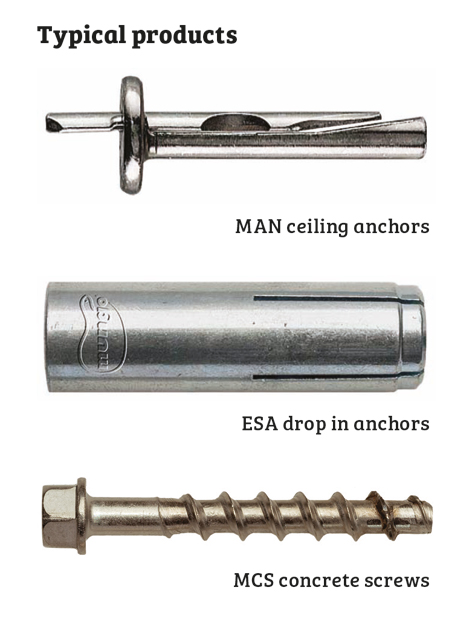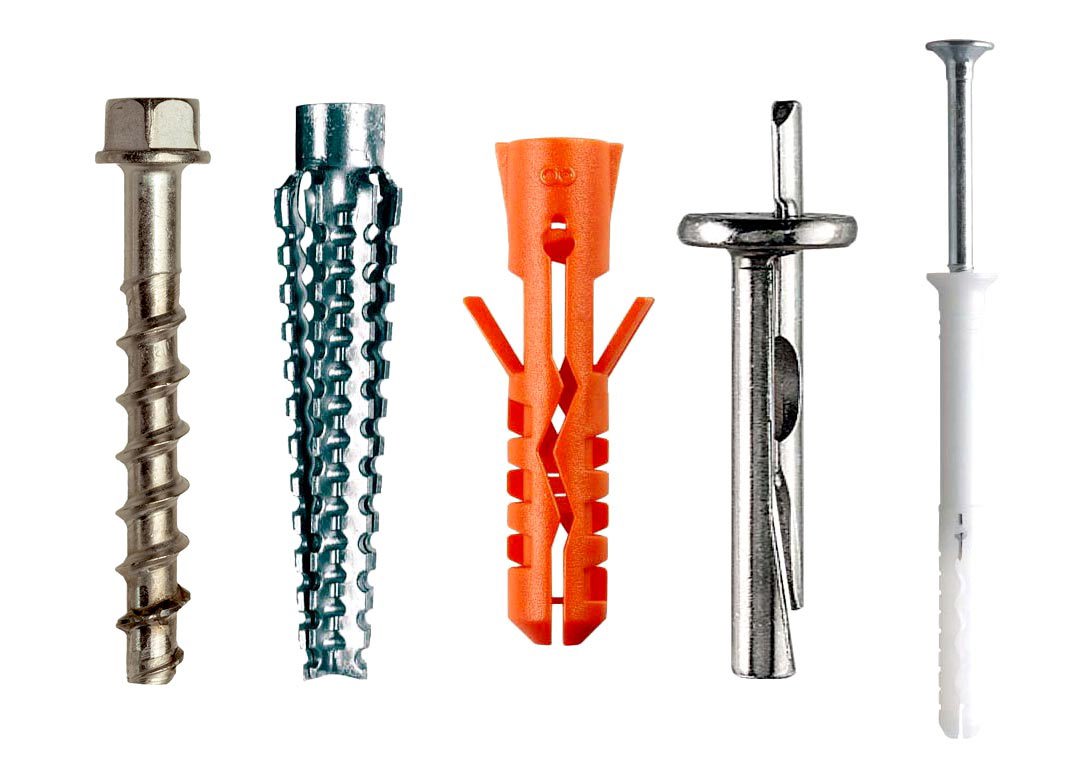The Crucial Overview to Recognizing Different Kinds Of Anchoring Systems
Comprehending securing systems is crucial for different applications, from marine to construction settings - Site Security Anchors. Various supports serve special functions based upon their environment and load needs. This overview discovers the different sorts of supports, consisting of ground, building, and boat anchors. It also resolves the products used and essential factors to consider for option. Each selection influences stability and reliability. Exactly what should one focus on when picking the ideal anchor? The answer exists ahead
Kinds of Watercraft Anchors
When selecting a watercraft support, recognizing the various kinds offered is essential for making certain security and safety on the water. The most typical kinds consist of the fluke support, understood for its lightweight layout and efficient keep in sand and mud; the plow anchor, which masters a range of seabed conditions as a result of its self-setting capability; and the mushroom anchor, preferred for its holding power in soft bottoms. An additional option is the grapnel anchor, usually utilized for small watercrafts and kayaks, suitable for rocky shallows. Each anchor type has details applications, adding to its effectiveness based on the vessel dimension and environmental conditions. Choosing the best anchor not just improves safety yet likewise enhances the general boating experience. Recognizing these distinctions permits seafarers to make educated decisions, guaranteeing they preserve control and security while going across diverse water bodies.
Building and Architectural Supports
Building and structural anchors play a necessary duty in guaranteeing the security and security of different building and constructions - Site Security Anchors. These supports are important elements that safeguard frameworks to their foundations or support group, avoiding activity as a result of environmental aspects such as wind, seismic activity, or dirt negotiation. Usual types consist of mechanical anchors, sticky supports, and development supports, each offering specific purposes based upon tons requirements and product compatibility
Mechanical anchors, as an example, are commonly made use of in concrete and masonry, offering high tensile toughness. Sticky anchors use chemical bonding to attain durable links, while growth supports are made to grasp the bordering material as they are tightened.
The option of an ideal anchor kind depends on elements such as tons ability, environmental problems, and the products involved. Appropriate installation and upkeep of these supports are essential for the durability and safety of the framework, highlighting their significance in building and design techniques.
Ground Anchors for Outside Structures
Ground supports play an important function in safeguarding outdoor structures versus ecological pressures. Different types of ground supports, together with their setup methods, determine their effectiveness and integrity. Furthermore, considerations pertaining to load ability are important for ensuring the architectural stability of these installments.
Sorts Of Ground Anchors
Supports work as the backbone for securing exterior structures, making certain security and safety in varying ecological problems. There are several kinds of ground supports, each designed for certain applications and dirt conditions. Helical supports feature a screw-like style, allowing for simple setup in numerous surfaces. Driven anchors are battered right into the ground, giving solid resistance versus side lots. Grouted supports use a bonding material to enhance stability, making them suitable for heavy frameworks. Deadman anchors contain a buried mass that disperses tons, suitable for retaining fencings and walls. Each kind serves an unique function, making it possible for home builders and designers to choose one of the most efficient securing system based on job demands and website conditions.
Installment Techniques Summary
Efficient setup strategies are essential for ensuring the efficiency and longevity of ground supports in outdoor structures. Appropriate site assessment comes before setup, where dirt problems and wetness levels are examined to determine viability. The option of the appropriate support kind must line up with architectural requirements and environmental variables. During setup, precision is vital; anchors ought to be placed at the proper deepness and angle to maximize their load-bearing capacities. Using the right tools, such as augers or hydraulic equipment, assists in exact placement and minimizes disturbance to surrounding dirt. Complying with maker standards for setup treatments is crucial to attaining peak anchor efficiency. Ultimately, post-installation assessments ensure that supports are safely in position and functioning as planned, therefore enhancing the security of the structure.
Load Capability Considerations
When evaluating load capability for ground anchors in outside frameworks, several crucial factors must be considered to validate safety and security and efficiency. The soil kind plays a significant role; natural dirts supply various holding capabilities compared to granular soils. Additionally, the support's design pop over to this web-site and product influence its toughness and longevity. Ecological problems, such as moisture and temperature level fluctuations, can additionally impact the anchor's efficiency gradually. The desired lots, consisting of vibrant and static forces, must be assessed to verify the support can endure tensions properly. Neighborhood guidelines and security requirements have to be stuck to during the selection and installment procedure. Properly evaluating these variables validates that ground supports work accurately and support outdoor frameworks firmly.
Specialty Anchoring Systems
Specialty anchoring systems are made to meet one-of-a-kind needs in numerous applications, supplying solutions where standard supports might drop brief. These systems deal with certain obstacles, such as those come across in undersea construction, high-altitude setups, or areas with unstable dirt problems. As an example, helical anchors are usually utilized in aquatic environments as a result of their ability to provide strong holding power in soft sediment. Rock supports are utilized in hilly areas for securing frameworks versus rockfall or landslides. Specialty systems might additionally consist of chemical anchors, which bond with substrates to boost load-bearing ability. In addition, they typically incorporate innovative design strategies to address environmental aspects, making certain safety and security in diverse conditions. By using customized layouts, specialty anchoring systems use options that enhance the toughness and performance of structures sought after situations, making them important in modern construction and engineering tasks.
Materials Made Use Of in Anchoring Solutions
The efficiency of securing systems is substantially influenced by the materials made use of in their building. Typical products consist of steel, light weight aluminum, and various synthetic compounds, each offering distinctive benefits. Steel, usually utilized for its toughness and resilience, provides durable support in tough environments yet is vulnerable to rust if not properly treated. Aluminum, lighter than steel, uses resistance to rust and is suitable for aquatic applications, although it may not support hefty lots as effectively. Synthetic materials, such as nylon and polypropylene, are significantly prominent because of their lightweight homes and resistance to environmental factors. These materials can also take in shock loads, enhancing total performance. The selection of product plays a vital function in the effectiveness and durability of securing systems, affecting their viability for details applications. Understanding these products permits far better decision-making in the design and choice of securing options.
Factors to Think About When Picking an Anchor
Selecting a support needs cautious factor to consider of several vital aspects that can significantly affect its efficiency and suitability for particular applications. The first element is the type of soil or substrate, as different anchors execute far better in varying problems such as rock, clay, or sand. Furthermore, the anticipated load, including dynamic and fixed pressures, need to be assessed to identify the support's toughness requirements.
The support's size and weight are likewise considerable, as they must match the vessel or structure being secured to ensure stability. Ecological conditions, such as tidal motions and weather patterns, can further affect anchor choice.
Moreover, the desired usage-- whether for momentary or irreversible applications-- will influence the selection of anchor kind. Compatibility with various other securing systems can improve overall safety and security and performance. A detailed assessment of these aspects assures the appropriate support is picked for peak performance.
Installation and Upkeep Tips

Regular assessments are important to determine wear, rust, or any indications of failing. Customers need to look for loosened elements and tighten up or change them as needed. Cleansing the support factors periodically can protect read against the buildup of particles that might compromise their honesty.
Furthermore, individuals must consider ecological variables such as wetness and temperature level, which may affect the supports' performance. Keeping documents of upkeep tasks can help track the system's problem in time. Following these methods will certainly improve the dependability and longevity of anchoring systems, inevitably contributing to the safety and security of the general structure.
Regularly Asked Questions
What Are the Ecological Effects of Different Anchoring Systems?
The ecological effects of numerous securing systems include damages to aquatic communities, debris disturbance, and possible injury to neighborhood wildlife. Sustainable practices can mitigate these impacts, advertising healthier undersea environments and protecting biodiversity in seaside locations.
Exactly How Do Laws Affect Anchoring System Choices?
Rules greatly affect anchoring system selections by imposing safety requirements, environmental managements, and operational guidelines (Duckbill Earth Technology). Users should conform with these demands, leading to the selection of systems that balance functionality, validity, and environmental considerations.
Can I Use Several Supports Together?
Making use of multiple anchors together is practical and frequently boosts security. One should consider the details problems and features of each support kind, guaranteeing they function sympathetically to accomplish the wanted holding power and safety.
What Are Common Mistakes When Making Use Of Anchoring Solutions?
Typical errors when making use of anchoring systems include inappropriate weight distribution, poor expertise of Affordable Ground Anchors environmental problems, overlooking regular tools maintenance, stopping working to represent tidal adjustments, and making use of inappropriate products, which can compromise safety and performance.
How Do Climate Problems Influence Support Efficiency?
Weather significantly affect anchor efficiency, as strong winds and stormy waters can increase pressure on the support. Additionally, hefty rainfall may change seabed problems, impacting the support's grip and general security throughout adverse weather occasions.
